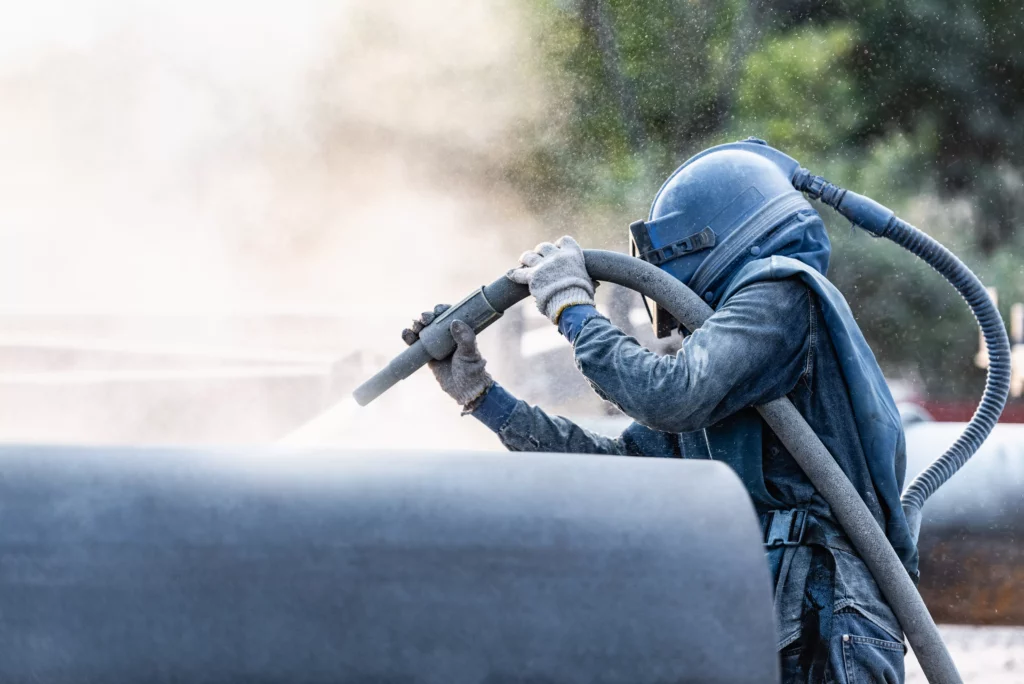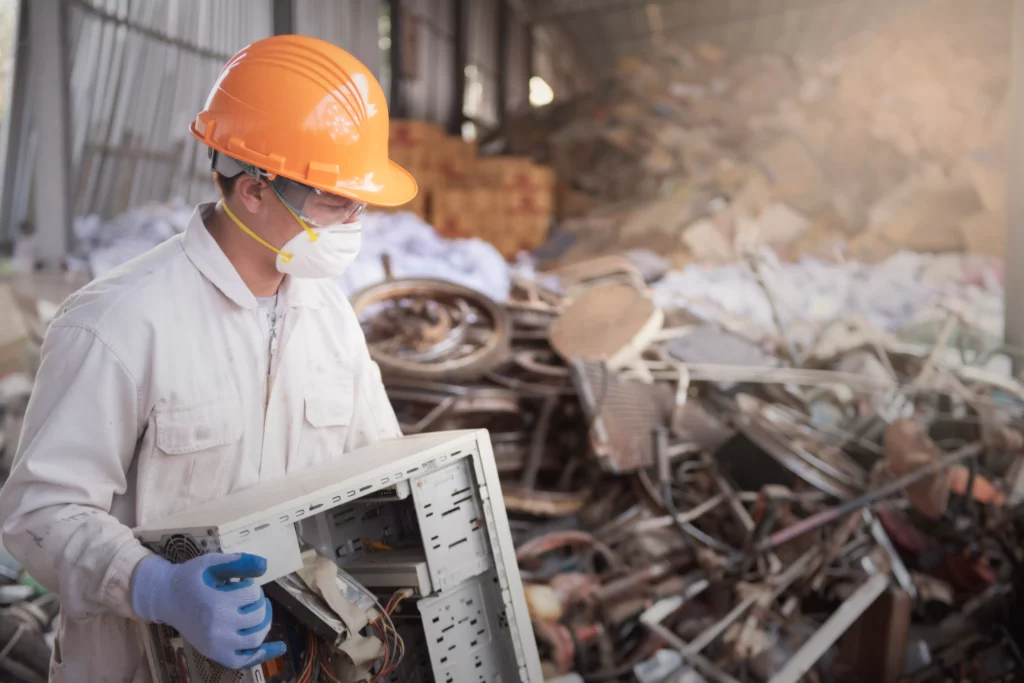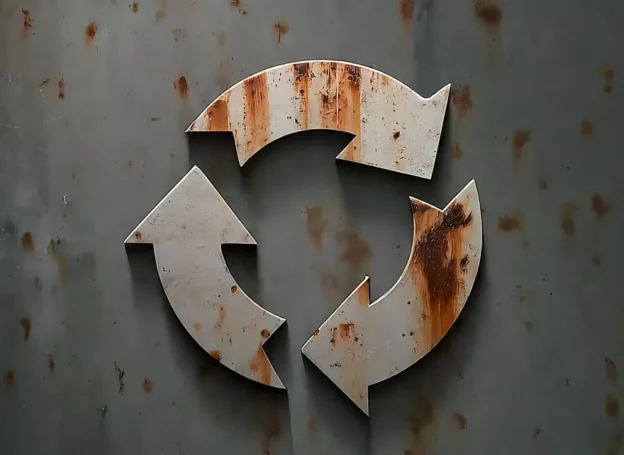Introduction
The circular economy, with its emphasis on reuse, recycling, and waste minimization, offers a refreshing contrast to the traditional linear approach of production and consumption characterized by the “take-make-dispose” cycle. However, within this sustainability paradigm, a considerable challenge arises: corrosion. This phenomenon not only compromises the durability and lifespan of materials but also questions their suitability for reuse and recycling practices, critical aspects of the circular economy.
This article discusses the multiple impacts of corrosion in the circular economy, analyzing how it specifically affects sectors such as oil and gas, among others. Additionally, we will explore how the circular economy model can be instrumental in offering innovative strategies to counteract and mitigate the adverse effects of corrosion, thereby enhancing sustainability and efficiency in the industry.
Impact of corrosion in the circular economy
Corrosion, characterized by the gradual deterioration of materials through chemical or electrochemical reactions with their environment, emerges as a formidable adversary on the path to a fully realized circular economy. This phenomenon not only compromises the integrity, quality, and safety of materials destined for reuse or recycling but also inflates the costs associated with maintenance and replacement of equipment and components, representing a significant economic burden for industries. Beyond these direct costs, corrosion exerts a detrimental influence on the efficiency of recycling processes.
Corroded materials require additional cleaning and processing procedures before they can safely reintegrate into new production cycles, resulting in increased energy consumption and utilization of other valuable resources. This rise in energy demand contradicts the fundamental principles of conservation and energy efficiency essential for the circular economy, exacerbating the environmental footprint of industrial operations.
From an environmental perspective, corrosion not only affects the direct reuse of materials but also introduces additional complexities into the product lifecycle. For example, corroded components ending up in landfills may release harmful substances into the environment, challenging the goals of waste minimization and pollution inherent in the circular economy.
Consequently, the effective management and prevention of corrosion become imperative both economically and environmentally to facilitate a successful transition towards more circular and sustainable practices in the industry, especially in resource-intensive sectors like oil and gas. Thus, the impact of corrosion on the circular economy extends beyond financial costs, profoundly impacting the sustainability and feasibility of adopting a more regenerative and environmentally respectful economic model.
Reuse of corroded materials
Material reuse represents a key strategy within the circular economy, aiming to maximize resource lifespan and minimize waste. However, corrosion poses significant challenges, compromising material quality and structural integrity, thereby limiting their effective reuse. Despite these challenges, several strategies and advanced technologies exist to rehabilitate corroded materials, facilitating their reintegration into the production cycle.
One of the most effective techniques to combat corrosion impact is surface treatment, including methods like sandblasting, polishing, and coating with anticorrosive materials. These processes not only remove existing corrosion but also prepare the surface for the application of protective coatings that prevent future corrosion damage. Coatings such as epoxy paints, hot-dip galvanization, and chemical conversion coatings offer a durable barrier against corrosive agents, extending material lifespan and enabling their reuse.
Furthermore, the implementation of advanced technologies as nanostructured coatings and corrosion-resistant alloys has proven particularly effective. These innovative solutions provide superior protection and self-repairing properties, critical in highly corrosive environments.
Case studies in industries like oil and gas, shipbuilding, and public infrastructure illustrate the success of these strategies. For instance, in the oil and gas sector, reusing corroded pipes after proper surface treatment and application of protective coatings has resulted in significant savings, both economic and environmental. These practices not only reduce the need for extracting and processing new materials but also decrease waste generation, aligning with the sustainability principles of the circular economy.

In summary, rehabilitating corroded materials for reuse is feasible and beneficial, thanks to the adoption of advanced surface treatment techniques and the use of protective coatings. These strategies not only address the challenge posed by corrosion but also pave the way for effective material reuse in critical sectors, promoting sustainability and resource efficiency in the circular economy.
Benefits of the circular economy in the industry
The transition to a circular economy model is not only a strategy for environmental sustainability but also positions itself as a significant competitive advantage for the industry. This model emphasizes the importance of careful material selection, durability-oriented design, reuse and recycling, and effective implementation of corrosion management systems, providing tangible benefits both in economic and environmental terms.
Firstly, the choice of materials more resistant to corrosion plays a crucial role. Materials such as stainless steels, aluminum alloys, and advanced composites, although they may require a higher initial investment, offer extended lifespan and reduce the need for frequent replacements. This not only decreases long-term maintenance costs but also minimizes waste generation, aligning with the principles of the circular economy.
Secondly, designing for reuse and recycling becomes an integral factor in mitigating the impact of corrosion. This involves creating products and components that, at the end of their lifecycle, can be easily dismantled and recycled, or their materials reused in new applications. Such an approach reduces the demand for virgin resources and limits waste production, contributing significantly to resource efficiency.
Lastly, implementing advanced and customized corrosion management systems for each specific industrial context allows for more effective monitoring and control of corrosion. These systems may include early detection technologies, predictive analysis, and preventive treatments, which can prolong asset lifespan and optimize maintenance processes. Improved efficiency and reduced downtime result in substantial economic savings and minimize the environmental impact associated with the extraction and processing of new materials.
In summary, the circular economy provides a valuable framework for addressing corrosion comprehensively, not only extending the lifespan of materials and components but also promoting resource efficiency and reducing environmental impact. These strategies, when widely adopted, have the potential to transform the industry, making it more sustainable and economically viable in the long term.
Recycling in the Industry
Recycling emerges as a fundamental pillar of the circular economy, facilitating the reintegration of materials into the production cycle and promoting more efficient resource use. However, the presence of corrosion poses a notable challenge, particularly in the recycling of metals and other susceptible materials. Corrosion not only compromises the quality of recycled material but can also significantly increase the costs and complexity of recycling processes.
To overcome these obstacles, the industry has begun to implement advanced separation and purification technologies that allow for the effective recovery of corroded materials. These technologies, including processes such as electrorefining for metals and dissolved air flotation techniques for plastics, are designed to separate valuable materials from corrosive contaminants. Additionally, the development of new recycling processes incorporating specific stages to address corrosion before reintroducing materials into the production cycle is contributing to minimizing material degradation and improving recycling efficiency.

The role of the recycling industry is crucial in this context, as innovations in the treatment and management of corroded materials open up new opportunities for efficient recycling. For example, the use of protective coatings and surface treatments on recycled metals can extend their lifespan and enhance their performance in subsequent applications. These practices not only facilitate resource reuse but also reduce reliance on virgin materials, aligning with the sustainability and waste reduction goals of the circular economy.
Conclusions
Corrosion, with its ability to weaken infrastructure and waste resources, poses a formidable challenge; however, it also acts as a catalyst for change, driving the development of new solutions that align engineering with sustainability.
From the smart reuse of corroded materials to the adoption of innovative recycling practices, the industry faces a path full of potential to mitigate the impact of corrosion while moving towards a circular economic model. The circular economy and the fight against corrosion, together, guide us towards a future where sustainability and efficiency are not distant ideals, but tangible and achievable realities.
References
Own source

